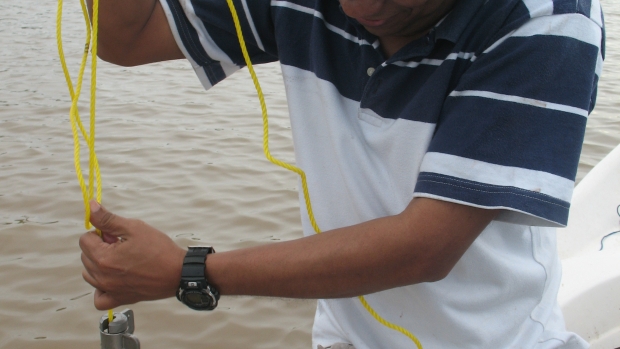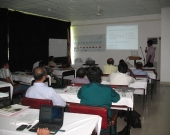Grants :: Small Grant Facilities :: Seasonal and spatial variation of physico-chemical parameters of water in the Panama lagoon
Seasonal and spatial variation of physico-chemical parameters of water in the Panama lagoon

Testing water quality in Panama lagoon , Panama © Kumudini Ekaratne, IUCN, 2012
Objectives
Study and document the current status of the Panama Coastal Wetland through assessing (a) spatial and temporal variation of water quality and (b) recording the current morphometry of the Lagoon.
Background
Panama is located in the east coast of Sri Lanka, 18 km south of Potuvil in the Eastern Province. Panama Lagoon (6° 46' N; 81° 49' E to 6° 46' N; 81° 46' E) is a semi-enclosed lagoon-type wetland, a shallow and relatively small of which most of the land area is utilized for agricultural activities. This semi-enclosed coastal lagoon is drained by a main tributary, however most of the storm-water from the urban area that empty directly into the lagoon. It is important to note that the morphometric parameters of the lagoon are currently not available. Panama lagoonal wetland is an important spawning and nursery habitat for fishes and, although impacted by urbanization, coastal wetlands still provide valuable and productive habitat for biota.
Degrading water quality due to human and natural courses leads to loss of environmental value of the ecosystem which is vital for the survival of habitats. If the water body is located close proximately to urban development centers, even at low intensity urban development can have negative effects on species diversity and assemblages over a long time period. Therefore, proper study of these ecosystems will require knowledge about ecological interactions, as well as external factors such as changes in seasonal patterns of stream flow, physic-chemical characteristics of source streams, and the type and amounts of pollutants that enter water courses from surface runoff. This is especially important considering that the combined effect of climate change and predicted land-use alteration in settled areas of the area concern. Land-use changes in the upstream and surrounding area could be increased siltation in coastal wetlands that would change the present morphometry of a wetland system. These morphometric characteristics are important in fishery development and management in coastal lagoons.
Water quality is determined by all physical, chemical and biological factors of water that influence the beneficial use of the water. Water quality deterioration in lagoons usually comes from excessive nutrient inputs, eutrophication, heavy metal contamination, organic pollution and obnoxious fishing practices. Physico-chemical parameters are the limiting factors for the survival of aquatic flora and fauna. Poor water qualities may be caused by low water flow, municipal effluents and industrial discharges.
Activities:
- Reviewing available information
- Sampling and measurements of water quality (Field & Laboratory)
- Collecting hydrological information (tidal levels, rainfall, etc.)
- Collecting of information on fish harvest and seasonal variation of the diversity of fishes
- Collecting bathymetric information and preparation of a digital bathymetric map of the lagoon
- Identification of pollution sources in and around the lagoon
- Identification of management priorities
Target beneficiaries
Researchers
Outputs
- Geo-referenced digital map of the Panama lagoon
- Detail information on the water quality of the lagoon
- Seasonal hydrological variations and its effects on water quality
- Document showing relationship between water quality and its effect on fish diversity and harvesting
- Point and non-point sources of pollutions
Accomplishments and challenges
The project was successfully completed.
Challenges:
No major issues have been encountered. However due to extremely high turbidity in water due to heavy rain, some chemical parameter measurements were unsuccessful in the 3rd sampling event.
Based on the comments made by two independent reviewers (NSC), sediment sampling was carried out.
In the initial stages of the project, rain water measurements were carried out at the Field Office site in Panama. However, the work could not be continued due to some logistic problem. Therefore, rain water data was obtained from the Meteorological Department Regional Centre in Pottuvil.
Contributions to cross-cutting themes
Changes in water quality of the lagoon due to inputs from the bordering land will severely affect the livelihoods of people and climate change will exacerbate the current situation.
Knowledge generated/research findings were shared with the relevant government institutions such as the Water supply and Drainage Board, Fisheries Department and Coast Conservation and Coastal Resource Management Department.
Lessons Learned
The results from this study show that physical water quality parameters such as salinity, turbidity, nitrate and chloride show strong seasonal variation.
Hydrochemically, the lagoon consists of three main segments namely the salt water segment, mixing region and the segment of fresh water inflow.
The effects of season and runoff are the major causes that control the variation in water quality; however human activities are interfering with this cycle. Several types of activities with increased point and non-point storm water runoff that are shunted directly into the lagoon have negatively affected the water quality.
The lagoon receives a substantial amount of water input from surrounding creaks, which are also associated with heavy nutrient inputs that are thought to have aided eutrophication in shallow areas of the lagoon. Solid waste from recreational activities was also increasing.
The baseline data obtained from this study provides information on major and trace elements for the understanding of spatial distribution, sources and associated potential ecological impacts in the Panama Lagoon.
The main lesson learned is that it is possible from a small project (Phase 2 Cycle 1) to expand to larger projects (this) and extend it in the future to even larger projects. For example, a Swedish university is interested in partnering with the Ecological Association of Sri Lanka to assist in carrying out studies on paleoclimatic changes in the east coast. (In fact, it is they who provided the sediment corer.)
Related News
Sri Lanka shares lessons learned from small grants coastal projects
Colombo, Sri Lanka 07 May 2013
Country: Sri Lanka
Topic: Knowledge for Management
Ten projects from the MFF Small Grant Facility in Sri Lanka met May 7, 2013 to share lessons learned over the past 11 months of implementation. During this lessons sharing workshop, project grantees revealed the potential of small projects to scale ...
Project Facts
Country
Location
Panama
Topic
Duration
1st Jun 2012 to 31st May 2013
MFF Grant Amount
LKR 743,400/-
Co-financing Partner
LKR 742,000/-
